Winter in Louisiana is a great time and place to catch speckled trout. They’re much closer to the dock and, if you don’t mind the cold, much easier to catch.

But where can you find these winter speckled trout?
That’s a great question. Louisiana’s coast is big, there are many places where winter speckled trout could be lurking.
Finding them can be difficult, as you can literally cover dozens of miles and not catch a single fish.
So, let me help you out by describing one kind of winter fishing spot you’ll want to seriously consider: dead end canals.
In this guide you will learn why these are great winter fishing spots and where to find them.
And, in order to do that, we must first look at what a dead end canal is, then why speckled trout go to dead end canals to begin with.
What is a dead end canal?
When I say “dead end canal”, I literally mean what the name implies: a man-made body of water that terminates at a dead end.

These can be short and straight, or they could be a series of canals with many turns.
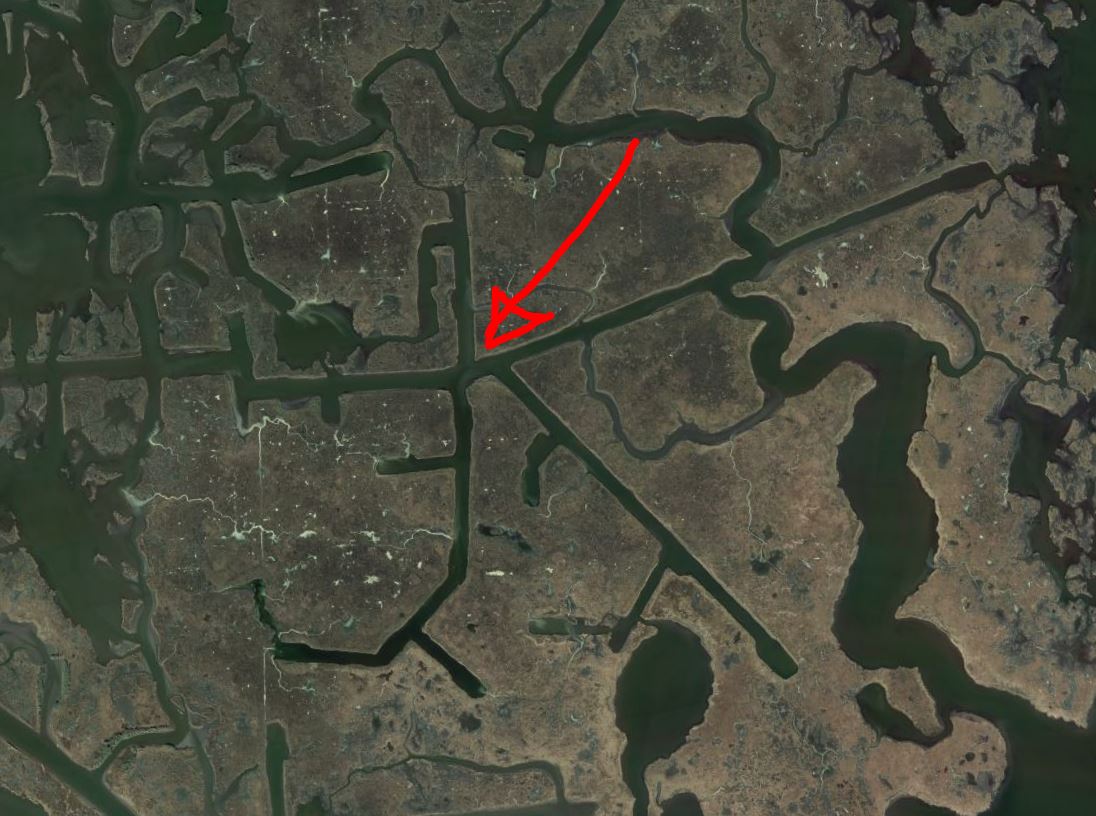
Either way, they don’t get much tidal movement due to their dead-end, and tend to offer some kind of protection from winter’s cold fronts.
This is important to bring up because many people in Louisiana incorrectly refer to bayous as being canals.
Doing so is misleading because both of these bodies of water are structured differently due to how they were made: one by man, the other by nature.
Big difference.
But not all these canals are created equally. Some are better than others, and this reality raises a very good question:
How can you know which dead end canals to fish?
In order to answer this, we must look at why speckled trout go to these canals to begin with.
Why Do Speckled Trout Go To Dead End Canals?
In a nutshell, trout seek out these locations to escape the harsh conditions of winter.
For this to make sense, you must understand that speckled trout are cold-blooded.
Their body temperature will more closely match that of the ambient water temperature than, say, a warm-blooded animal living in the water such as a dolphin.
As a result, speckled trout are more affected by rapidly changing water temperature than warm-blooded animals.
So, when they change their location after a cold front, it’s usually to a place that offers a stable environment where the temperature does not change as much.
The alternative is staying in water that is rapidly changing in temperature, too fast for their body to keep up with.
If they did this, then chances are they would die. So, when a cold front hits, they know to seek deep and protected water.
Now that we know this, let’s return to our previous question: How can you know which dead end canals to fish?
Let’s take a look at some key details.
Key Details For Productive Dead End Canals
A good dead-end canal that is worth your time will have the following key details:
Protection From North Wind
The first one, being protected from a harsh northwest wind, is critical.
The cold, strong wind brought on by a cold front will muddy the water and cool it off, making it less appealing for fish to remain in.
Speckled trout don’t enjoy dirty water that is rapidly cooling off. So they move to where the water is protected and, as a result, enjoy water that is clean and stable.
Additionally, these tend to be places that have a south-facing shoreline or, at the bare minimum, aren’t open to a north wind.
After that, relative water depth is important. A productive dead-end canal tends to be deeper than the surrounding marsh, but only relatively.
There is no magic number that works for speckled trout. So, this depth could be six feet if the surrounding marsh is 2-4ft deep.
Or, it could be 25ft if the surrounding area is 12 feet deep.
It just depends, so the thing to focus on here is relative water depth.
Still Water (or lack of current)
Next is still water, which is a term I use for bodies of water that don’t get much tidal movement.
This is due to their having a dead-end. Water cannot flow through it, only in and out.
I think that “still water” is a good place for speckled trout (and even redfish) to take refuge after a strong cold front.
I feel that this is because it’s easier for them to adapt to dropping temperature in a place where they don’t have to swim against the current.
Whatever the reason, we sure do catch a lot of fish where there is little to no current when it gets cold.
Cover For Bait = Bonus
Lastly, a good bonus is some obvious cover that bait can live and grow in.
Good examples include, but are not limited to: rock piles, aquatic grass and oysters.
Now, a dead-end canal does not need to have all of these key details in order to be worth fishing. Only some.
I’d say that protection from a north wind and relative depth are the most important, the rest are something of a bonus.
I wouldn’t harp on still water so much because we do catch fish in strong current during winter.
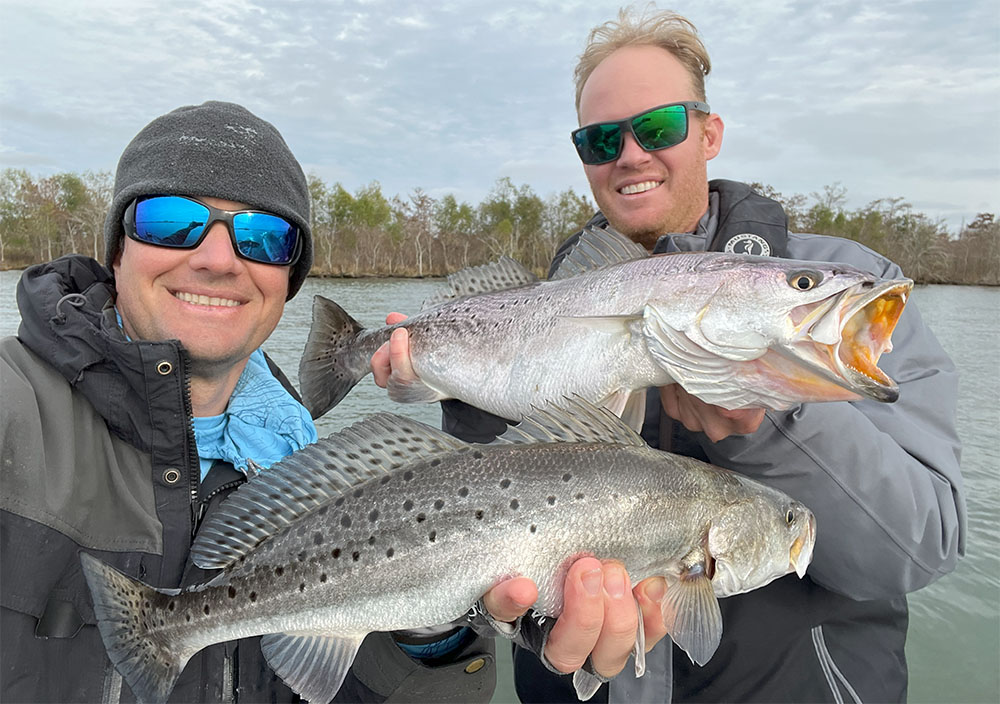
Lately, I’ve been fishing the Mississippi River a bunch (see above) with the water temp in the mid to low 50s, and I’ve been catching limits of speckled trout where the water is absolutely ripping.
With that said, I do seem to do better when the water isn’t ripping as hard, and it is worth mentioning that I have not caught all those fish in dead end canals.
If you're a member of LAFB Elite, then you've seen those reports inside the community.
Dead End Canals Proven To Produce Speckled Trout
So, with that out of the way, let’s look at some examples of dead-end canals on Google Earth Desktop.
We will look at proven dead-end canals, bad examples and some ideas I have that you will find worth trying.
Michoud Canal
Located at 30° 1' 5" N 89° 54' 27" W
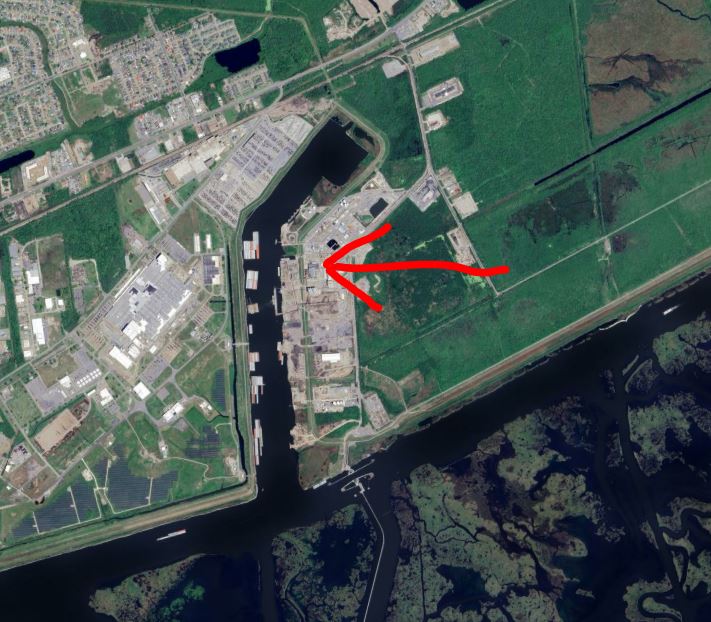
The Michoud Canal is a winter time favorite for speckled trout whenever cold fronts roll through. I would say that it’s the “ultimate” example of what a good dead-end canal is supposed to look like.
It’s 30 feet deep, protected from a north wind by levees and infrastructure, features consistent still water and is lined with rock piles that baitfish like to live in.
Casting a jig to these rocks is a great way to catch some quality winter speckled trout.
But not all canals are this big and obvious, so let’s look at another example in Dularge.
Dularge Canals
Located in vicinity of 29° 25' 25" N 90° 49' 13" W

Lake Decade in Dularge by itself is a renowned winter speckled trout spot.
Drifting here for specks is productive, but everyone agrees that dead-end canals in the area can become really good when the temperature drops.
Note that these canals are much smaller than Michoud, but they still provide the protection that fish seek from a harsh north wind.
There aren’t any obvious rock piles like in Michoud, so jigging the bottom or even popping a cork could be a good choice here.
Myrtle Grove Canal
Located at 29° 37' 46" N 89° 57' 8" W
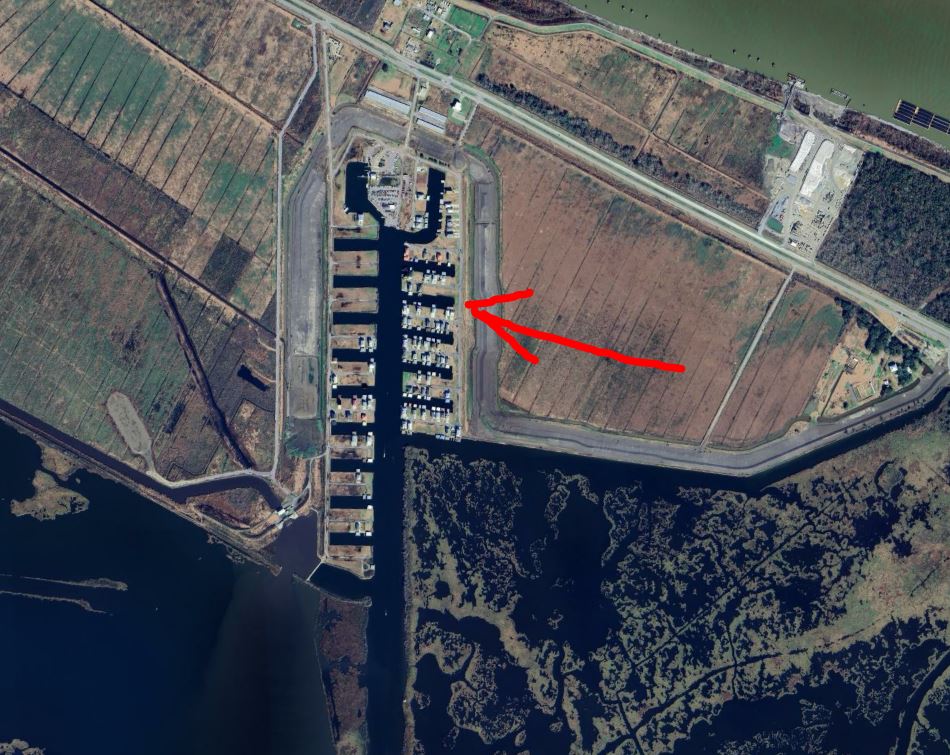
This one sets up a lot like the Michoud Canal in New Orleans.
It runs north to south and is protected from a north wind, not just by the way it is structured, but also by the surrounding infrastructure.
It’s no surprise that when the water temp takes a plunge we find speckled trout and redfish here.
This canal also has some depth to it. It is relatively deep compared to the marsh further south of it.
Now, I’m not saying go fish these exact spots. What I am saying is “use these as a template to find your own”.
Think about it: these are three different locations across Louisiana’s coast on both sides of the Mississippi River.
They don’t turn on at the same time by happenstance, they turn on because they have those key details speckled trout look for when it gets cold.
I’m telling you, they are not the only dead-end canals in Louisiana that have a bunch of fish in them.
What you really need to do is get on Google Earth Desktop and look for similar dead-end canals away from these examples. That’s because so far what I’ve shown you are community holes that everyone knows about.
What you really want to do is find your own fish. It’s more rewarding and you won’t have to worry about them getting pressured by the Flotilla.
Examples Of Dead End Canals You Should Avoid
But, before you take off to do that, let me show you examples of dead-end canals you don’t want to fish.
This way you have a better idea as to what you’re looking for and can pick out better spots to try fishing.
East Biloxi Marsh Dead End Canal
Located at 29° 49' 34" N 89° 19' 4" W

The East Biloxi Marsh is a proven winner for catching speckled trout, so it makes sense to look for dead canals there, right? Well, not this one.
The problem with this one is that it’s way out in the middle of nowhere.
Even if there were speckled trout at this location, you would have to drive past a lot of other productive spots before you got there.
That’s a pretty far run to catch specks during winter.
However, I don’t think speckled trout would be here to begin with. That’s because this dead end canal is too shallow.
If you flip through historical satellite imagery, you will see that the bottom becomes exposed during a hard north wind.
Simply put, this canal is not relatively deeper than the surrounding area.
It’s a no-go for winter speckled trout.
Hopedale Dead End Canal
Located at 29° 48' 55" N 89° 40' 10" W
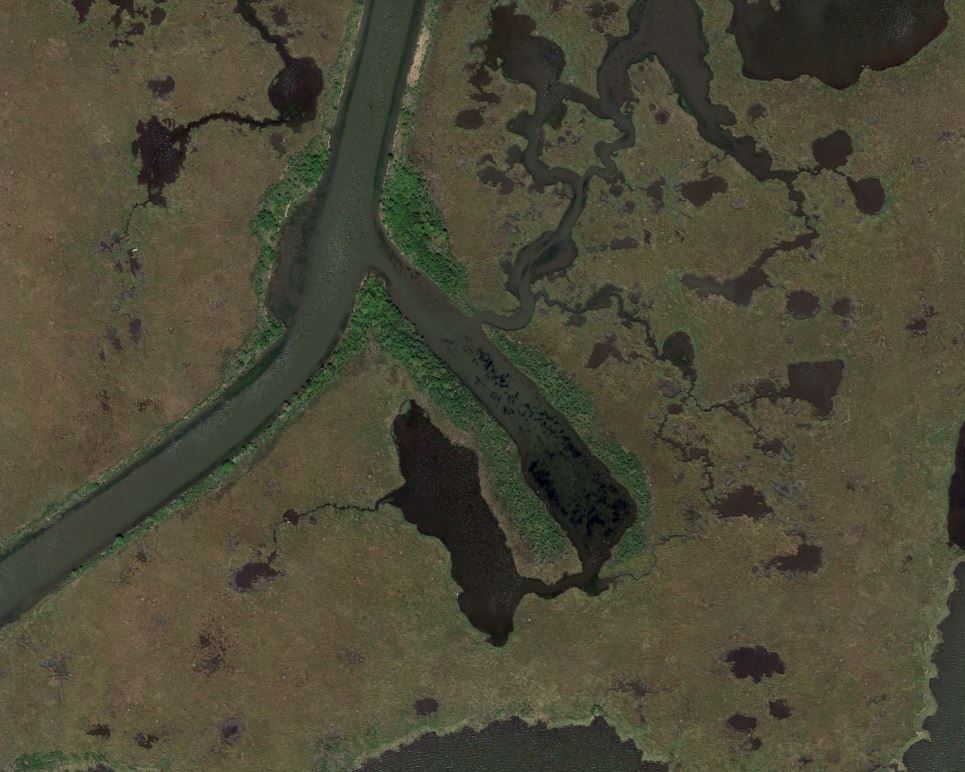
Our next bad example takes us to Hopedale.
Now, this one is much closer to the launch. If you were looking at this spot on a paper map or fancy mapping chip, then it would appear to be worth trying.
Spoiler alert: it’s not.
About Those Fancy Mapping Cards...
I did look at it on my two mapping chips on my boat: my Standard Mapping E-Card and Lakemaster Louisiana Delta card.
This is further reason to use Google Earth Desktop over over-priced mapping cards.
It’s not because it’s obviously shallower than the surrounding marsh, and this detail is revealed inside historical satellite imagery.
On top of that, it’s pointed to the southeast, rather than the northwest.
I sure do prefer dead-end canals to be pointed northward. During a strong cold front you can count on the wind to blow straight down this one, making it tough to fish.
Yes, it is somewhat protected by the opposite shoreline, but this southeast configuration sure doesn’t make it appealing.
Devil’s Elbow Canals
Located in vicinity of 29° 52' 20" N 90° 8' 59" W

Now, west we go to Westwego (see what I did there?), to take a look at the canals off Bayou Segnette near a place called Devil’s Elbow.
I’ve spent a lot of time back here and I can tell you that most of these canals have all the good ingredients for a productive winter fishing spot.
They’re protected from a harsh north wind, they’re relatively deep, they have consistent still water and possess tons of cover for bait fish.
But there aren’t speckled trout in these canals.
Sometimes you’ll catch a lost sheepshead or redfish, but it’s not a place you’d go to catch a hundred fat, Louisiana winter specks.
The reason Devil’s Elbow isn’t that great for speckled trout is because it’s too far inside the marsh.
The biomass of winter speckled trout just doesn't come this far inside, especially since the Davis Pond Diversion.
Anything can happen with the Saltening, but I would look further south toward Lafitte for winter speckled trout.
What else is there besides dead-end canals?
These places are the opposite of what you want to fish and, since we looked at them, you now have an idea what not to look for in a productive dead-end canal.
This completely answers our earlier question of “How can you know which dead end canals to fish?”
Now you have an idea where to begin looking to catch winter speckled trout.
But what about other locations? Surely speckled trout are caught somewhere besides dead end canals, right?
Well, they are. And one reason speckled trout would leave the safety of a good dead end canal is because the conditions changed after the water temperature dropped.
This and more is what I detail inside my course Winter Fish Location, a seasonal course that builds upon the foundational knowledge of Inshore Fishing 101.
Both of these courses put together are everything you need to know to successfully catch limits of speckled trout and redfish on Louisiana’s coast, completely from scratch.
Inside Inshore Fishing 101 you will find 56 video lessons featuring over 12 hours of instruction.
This is not a TikTok on someone else’s boat, it’s not a YouTube video of catching a mixed box by accident, it’s the real deal created by someone who goes on amazing fishing trips on a regular basis.
If you’re not sure, just look at my fishing reports, or the videos on my fishing trip YouTube channel and the B-roll you see in the video embedded above.
I won’t beat around the bush: I catch a lot of fish!
And, if you look closely, you will see that I am not fishing the same ol’ spot at the same ol’ time of year. Yes, I fish all over Louisiana’s coast and catch fish.
This is because I am well versed in fishing the conditions and have a process used to locate speckled trout and redfish anywhere they swim.
That process is what I teach inside Inshore Fishing 101 and Winter Fish Location.
But it’s not for everyone. Some people just want fishing spots handed to them and aren’t willing to learn. That’s too bad for them, because they’ll never catch as much as they could if they had an open mind.
Having an open mind and willingness to learn how to fish the conditions is key to succeeding. All I can do is show you the door, it’s up to you to open it.
The anglers who did have enjoyed the success they were looking for and posted the fishing reports to prove it.
Joining LAFB Elite is how you open that door.
If you have any questions, comments, or simply something to add, then please do so in the comments section below.
Thanks for reading, and tight lines!


That depends on the situation at hand. If there’s 30ft of water then throwing a topwater would be an effort in futility, more likely than not. I strongly suggest watching this video: https://www.lafishblog.com/free-fishing-course/
If you’re looking to catch fish in general, and especially limit out, then lure color is not the problem you need to solve. What you need to do is find biting fish in the first place. If you do that, it really won’t matter what color you throw. With that said, chartreuse is a good overall color to start with for inshore fishing.
Is it better to use top water lures or fish the bottom?
What are the best color plastic lures to use during the fall/winter months?
Jason, you’re welcome, and thank you for taking time to visit my site!
Thank you so much for this lesson. So much good information here and the good examples vs bad examples is what really helps drive it home and gets me using my head. Sure appreciate all you do to help make us better anglers. Thank you again
That’s a good question. I don’t really have time to do that, though I would love to. That would certainly be fun. But I do think you can apply what’s laid out here in this guide to BSL. The same principles apply, specifically the items listed under “Key Details For Productive Dead End Canals”. That’s the juice.
I just tie directly to the cork. I really don’t like snap swivels and don’t use them for anything, and just prefer to tie a knot. I haven’t really found changing depth under a cork to be that important, either. I think what’s important is being prepared to fish the entire water column, and this almost always requires a separate rig for fishing the bottom, like a Carolina rig or jig.
Under a popping cork, i.e. cajun thunder, four horseman, do you recommend to tie a leader to the cork directly or with using a snap swivel? I usually fish with 12 lbs. mono then 15 or 20 # leader, but with a snap swivel for quick changing after a break or different depths. I see where some suggest this is not good, however, I am not sure. Thanks for your input.
Would you kindly look over the St Louis Bay Area when you get a second and tell me what you think pertaining to this topic?